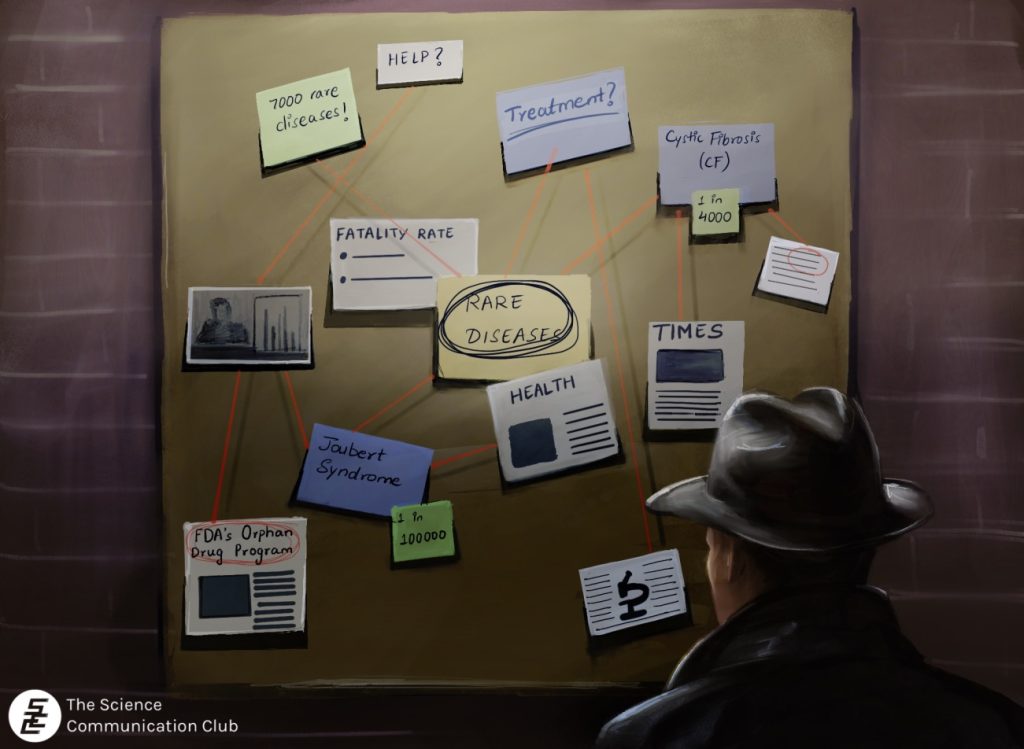Authored by Sydney Steiman
Illustrated by Aryan Hrishikesh Nair
Rarity to Relevance: The Importance of Studying Rare Diseases and Their Hidden Potential
How can I persuade you to read about a topic you may never have heard of, might know little about, and a disease you may not be familiar with or know anyone who is affected by it? This is often the fundamental challenge when communicating the importance of studying rare diseases.
Rare diseases are medical conditions that affect a small percentage of the population, fewer than 200,000 people in the United States, often impacting children. This rarity creates significant barriers for both patients and researchers, specifically when it comes to diagnosis and treatment options.¹ Many people I’ve spoken to who ask me about my research often respond with the same question: “If it’s so rare, why should I care?” This is the question I aim to answer. Despite the rarity, there are currently over 7,000 different rare diseases, each unique, with the majority having genetic causes.¹ The way they affect patients, the treatment options available, the severity, the organs impacted, and their prevalence in the population are all distinct for each disease. For example, one of the most well-known rare diseases is cystic fibrosis (CF), which affects roughly 1 in 4,000 live births in Europe and causes mucus to build up in the lungs, which can lead to severe respiratory problems.² On the other hand, a lesser-known disease is Joubert syndrome, which affects approximately 1 in 100,000 live births, with an average mortality rate of just 7 years. Symptoms of Joubert syndrome include intellectual disability, abnormal breathing, and lack of muscle control. Like many rare diseases, Joubert syndrome has no cure, and most treatments are merely supportive and symptomatic.³

In the current advanced era of cancer treatments and artificial intelligence, you might be wondering, “How have we not developed potential treatments for all diseases?” The first answer lies in the impact of rarity on diagnosis. Take for example CF, where a definitive diagnosis requires blood tests, genetic testing, and thorough clinical evaluation, all of which require labs to run samples, physicians with knowledge of the diseases, and technologists to analyse data.² Additionally, many rare diseases share overlapping symptoms, such as seizures and intellectual disability, leading to frequent misdiagnosis or missed diagnosis.¹ All of which can prevent patients from accessing crucial care opportunities. When it comes to targeted therapeutic development and improved diagnostics, small patient populations make data collection and the possibility of clinical trials particularly challenging.
Now that you have a broader understanding of what rare diseases are and the difficulties in studying them, you might ask, “What’s the benefit of researching rare diseases?” Acknowledging and studying rare diseases is essential because these conditions can have a multitude of symptoms, reduced quality of life, and, in some cases, death for some patients. The field of rare disease research has driven the development of many technologies and treatments now used for more common conditions. For instance, research into the modelling mutations in the rare disease Niemann-Pick disease, Type C1 has improved our understanding of the BRCA1 gene.⁴ The importance of studying rare diseases has been recognized by the creation of many charities and organizations such as Reverse Rett, the Bardet-Biedl Syndrome Foundation, and The Blu Genes Foundation.⁵ʼ⁶ʼ⁷ These organizations are often created by families affected by these conditions who recognize that there is a gap in the field when it comes to addressing certain rare diseases. The importance of research is also reflected by the FDA’s Orphan Drug Program which offers incentives such as tax credits, grants, and market exclusivity to encourage the development of treatments for rare diseases.¹ When researchers like me investigate rare diseases, we take unique and new approaches because often, so little is known. In our efforts to model diseases in laboratory settings for therapeutic development, we utilize cutting-edge genetic editing techniques to create patient-mimicking models. We often take a ‘kitchen sink’ approach to research, trying innovative gene editing methods to reverse mutations or screening thousands of FDA-approved drugs for potential repurposing. In a field that values the uniqueness of each condition, no idea is too small to attempt. I hope I’ve shown you that if one day you encounter the question, “If it’s so rare, why should I care?” you can offer a newly well-informed answer. While rare diseases like Joubert syndrome and Huskins’ syndrome affect a small portion of the population, it’s crucial to recognize the significant impacts they have on patient’s lives beyond mere statistics.
References
- Griggs RC, Batshaw M, Dunkle M, Gopal-Srivastava R, Kaye E, Krischer J, Nguyen T, Paulus K, Merkel PA. Clinical research for rare disease: Opportunities, challenges, and solutions. 2009. doi.org/10.1016/j.ymgme.2008.10.003
- Farrell PM, White TB, Ren CL, Hempstead SE, Accurso F, Derichs N, Howenstine M, McCollet SA, Rock M, Rosenfeld M, Sermet-Gaudelus I, Southern KW, Marshall BC, Sosnay PR. Diagnosis of Cystic Fibrosis: Consensus Guidelines from the Cystic Fibrosis Foundation. 2017. doi.org/10.1016/j.jpeds.2016.09.064
- Brancati F, Dallapiccola B, Valente EM. Joubert Syndrome and related disorders. 2010. doi:10.1186/1750-1172-5-20
- Erwood S, Bily TMI, Lequyer J, Yan J, Gulati N, Brewer RA, Zhou L, Pelletier L, Ivakine EA, Cohn RD. Saturation variant interpretation using CRISPR prime editing. 2022. doi.org/10.1038/s41587-021-01201-1
- Reverse Rett [accessed 2025 Mar 3] https://www.reverserett.org.uk/
- Bardet Biedl Syndrome Foundation [accessed 2025 Mar 3] https://www.bardetbiedl.org/
- Blu Genes Foundation, Advancing Gene Therapy. Offering Hope. [accessed 2025 Mar 3] https://blugenes.org/
